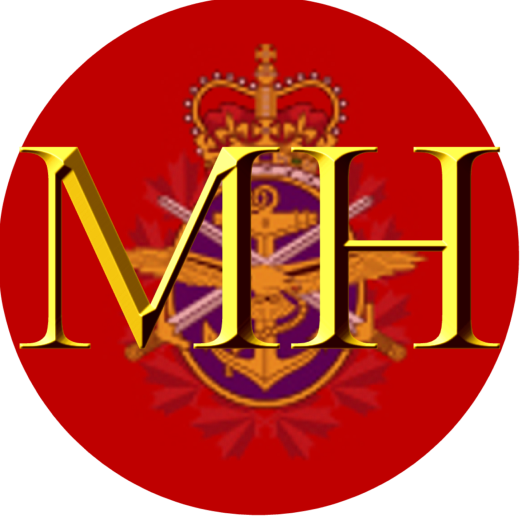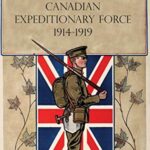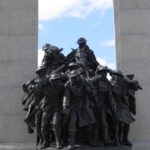The Canadian Military in the First World War: A Survey
The First World War (1914-1918) marked a defining period in Canadian history, shaping the country’s military, political, and social landscapes. Canada’s involvement in the war transformed it from a relatively isolated dominion of the British Empire into a significant player on the international stage. Before the outbreak of war, Canada had little military experience, a small army, and a fledgling navy, but by the end of the conflict, its contributions on land, at sea, and in the air would help secure victory for the Allies. This essay explores the conditions in Canada prior to the war, the nation’s response to its outbreak, the mobilization of its military forces, the role and experiences of Canadian soldiers on the Western Front, the politics surrounding Canadian forces within the British Empire, naval development, the role of Canadian pilots in the air war, and Canada’s overall contribution to the Allied victory.
Pre-War Conditions in Canada
In 1914, Canada was a relatively young nation, having achieved Confederation only 47 years earlier in 1867. Its population was just over 7 million, and the country was largely agrarian, with rapidly growing urban centers such as Toronto, Montreal, and Vancouver. The economy was heavily reliant on agriculture, natural resources, and trade, particularly with Great Britain, which remained Canada’s primary economic partner.
Militarily, Canada was ill-prepared for a large-scale conflict. The Permanent Active Militia, Canada’s small regular army, numbered only about 3,000 troops, supplemented by the Non-Permanent Active Militia, a volunteer force that stood at around 74,000 men, though many of these were poorly trained and equipped. Canada had little experience in warfare beyond limited participation in the Boer War (1899-1902), where roughly 7,000 Canadian volunteers served. The defense of Canada, particularly against potential threats from the United States, was largely dependent on Britain.
The Canadian Navy, officially founded in 1910 with the passage of the Naval Service Act, was in an embryonic stage. Canada possessed only two aging warships: HMCS Niobe, a former British cruiser stationed on the east coast, and HMCS Rainbow, a second-hand cruiser on the west coast. Both ships were outdated and minimally equipped to defend Canada’s vast coastlines. This modest naval force reflected a country that had only just begun to consider its role in maritime defense, leaving most naval duties to the British Royal Navy.
Canada’s Reaction to the Outbreak of War
On August 4, 1914, Britain declared war on Germany, automatically bringing Canada, as a dominion of the British Empire, into the conflict. Despite having no formal say in the decision to go to war, Canada’s response was one of overwhelming support, particularly from the English-speaking population. Canada’s Governor General, the Duke of Connaught, quickly pledged Canadian support, and Prime Minister Sir Robert Borden declared that Canada would stand shoulder to shoulder with Britain in the war effort. This sentiment of loyalty to the Empire resonated strongly in English-speaking Canada, where ties to Britain were deep, both culturally and politically.
Enthusiasm for the war was widespread, and recruitment centers were quickly overwhelmed with volunteers. In English-speaking provinces, young men flocked to enlist, motivated by patriotism, a sense of adventure, and a belief that the war would be short and glorious. Within a month, over 30,000 Canadians had signed up to fight, surpassing the government’s initial target of 25,000 men.
However, reactions in French-speaking Quebec were more muted. Many French-Canadians did not feel the same connection to the British Empire, and there was little enthusiasm for a war fought in Europe on behalf of British interests. While Quebec did provide volunteers, they did so in smaller numbers compared to English-speaking provinces. This divide would later become a critical political issue, especially during the Conscription Crisis of 1917, but in the early months of the war, Canada’s diverse population largely supported the war effort.
Mobilization and Military Organization
Canada’s rapid mobilization in response to the outbreak of war was directed by Sir Sam Hughes, Canada’s Minister of Militia and Defence. Hughes was a highly energetic and ambitious leader, but his management of the war effort was often chaotic. He quickly established Valcartier Camp in Quebec, where volunteers were gathered, trained, and organized into what would become the Canadian Expeditionary Force (CEF). Valcartier was initially ill-prepared to handle such large numbers of recruits, and training facilities were rudimentary, but Hughes’ efforts allowed the first contingent of the CEF, consisting of over 30,000 men, to embark for England in October 1914.
Hughes insisted on equipping Canadian soldiers with Canadian-made equipment, leading to the adoption of the Ross Rifle, a precision weapon that performed well in target shooting but proved disastrous in the muddy, close-quarters conditions of trench warfare. The Ross Rifle frequently jammed, and Canadian soldiers quickly grew frustrated with its unreliability in battle. Despite these shortcomings, the CEF would go on to distinguish itself in some of the most crucial battles of the war.
Upon arriving in England in November 1914, the Canadian soldiers were stationed at Salisbury Plain, where they underwent further training in preparation for deployment to the Western Front. By early 1915, the 1st Canadian Division was sent to France, marking the beginning of Canada’s significant military involvement in the war.
Canadian Military Participation on the Western Front
Canada’s participation in the First World War was characterized by its involvement in several of the most important and grueling battles of the conflict. Over the course of the war, more than 620,000 Canadians enlisted in the military, with approximately 425,000 serving overseas. By the war’s end, more than 60,000 Canadians had died, and another 172,000 were wounded.
Ypres (1915)
The Second Battle of Ypres in April 1915 was the first major engagement involving Canadian troops. The battle took place in the Ypres Salient in Belgium, where Canadian forces faced the first use of chlorine gas by the German Army. Despite suffering heavy casualties from the gas attacks, the Canadians held their positions, preventing a German breakthrough. This battle earned Canadian soldiers a reputation for bravery and resilience, but it also came at a great cost, with over 6,000 Canadian casualties.
The Somme (1916)
In 1916, Canadian forces participated in the Battle of the Somme, one of the bloodiest battles in human history. The Canadian Corps joined the battle in August, participating in the attack on Courcelette. Although the Somme offensive resulted in significant territorial gains for the Allies, the human cost was staggering. Canada suffered more than 24,000 casualties during the Somme campaign, which came to symbolize the futility of trench warfare and the enormous toll it took on soldiers.
Vimy Ridge (1917)
The Battle of Vimy Ridge in April 1917 remains one of the most celebrated moments in Canadian military history. For the first time, all four divisions of the Canadian Corps fought together in a carefully coordinated assault to capture the heavily fortified German positions at Vimy Ridge, a key strategic point in northern France. Under the command of General Sir Julian Byng and later General Arthur Currie, the Canadians executed an innovative plan that involved meticulous preparation, extensive use of artillery, and the construction of tunnels to bring troops close to the enemy lines. The capture of Vimy Ridge was a significant victory for the Allies and is often regarded as a defining moment in the development of Canadian national identity. More than 10,000 Canadians were killed or wounded in the battle, but it marked Canada’s emergence as an effective and independent military force.
Passchendaele (1917)
Later in 1917, Canadian forces were involved in the infamous Battle of Passchendaele, a campaign fought in the rain-soaked fields of Flanders. The battlefield had turned into a quagmire of mud, and Canadian soldiers faced near-impossible conditions as they attempted to capture the ruined village of Passchendaele. Despite the horrific conditions, the Canadians succeeded in taking their objectives, but the victory came at a heavy cost—over 15,000 Canadian casualties.
Hundred Days Offensive (1918)
During the final months of the war, Canadian troops played a key role in the Hundred Days Offensive, a series of Allied attacks that finally broke the German lines and forced the German Army into retreat. The Canadian Corps, under the leadership of General Arthur Currie, spearheaded many of the key offensives during this period, including battles at Amiens, Arras, and Cambrai. The Canadian forces earned a reputation as “shock troops,” frequently assigned the most difficult and important tasks. The Hundred Days Offensive culminated in the liberation of towns and cities in France and Belgium, and Canada’s contribution to these final victories was critical in bringing about the armistice on November 11, 1918.
Politics of the Canadian Military in Relation to the British Empire
Throughout the war, the relationship between Canadian forces and the British Empire was complex. As a dominion of Britain, Canada’s military forces were initially under British command, and Canadian soldiers fought alongside British and other imperial troops. However, as the war progressed, Canada sought greater autonomy over its forces and its role in the conflict.
The creation of the Canadian Corps in 1915 was a significant step toward greater independence. Initially commanded by British generals, the Canadian Corps was later placed under the leadership of General Arthur Currie in 1917, making him the first Canadian-born commander of the Corps. Currie proved to be a highly capable and innovative leader, and under his command, the Canadian Corps became one of the most effective fighting units on the Western Front.
Prime Minister Robert Borden also played a key role in asserting Canada’s political independence within the Empire. Borden argued that Canada, along with other dominions, deserved a greater voice in imperial decision-making. In 1917, his efforts led to the creation of the Imperial War Cabinet, in which Canada and other dominions were represented in discussions about the war’s prosecution and the post-war settlement. This was a significant step toward Canada’s growing political autonomy, and it laid the groundwork for the country’s evolving status within the Empire, which would eventually culminate in full legislative independence with the Statute of Westminster in 1931.
The Home Front: Society, Economy, and Politics
While Canadian soldiers fought overseas, the war effort dramatically reshaped life on the home front. The government introduced a range of measures to support the war, including war bonds, increased taxation, and the introduction of income tax in 1917 to fund the war effort. The war also accelerated industrialization, with munitions factories and other war-related industries expanding rapidly. Cities like Toronto, Montreal, and Vancouver became hubs of wartime production, contributing to economic growth but also creating social tensions as workers faced inflation and labor shortages.
Women played a crucial role on the home front, filling jobs left vacant by men who had gone to fight. Women worked in factories, on farms, and in offices, taking on roles that had previously been closed to them. This shift helped spur the movement for women’s suffrage, and in 1917, women gained the right to vote in federal elections if they had close relatives serving in the military. By 1918, most women over the age of 21 were granted the right to vote in federal elections, a significant political milestone.
However, not all Canadians were enthusiastic about the war. In 1917, the government faced a major political crisis over the issue of conscription. By this point in the war, volunteer enlistment had slowed, and casualties were mounting. Prime Minister Borden, recognizing the need for more soldiers, introduced the Military Service Act, which imposed conscription. This decision sparked fierce opposition, particularly in Quebec, where many French-Canadians felt little connection to the British cause. The Conscription Crisis led to riots and deepened the divide between English and French-speaking Canadians, but Borden pushed ahead with conscription, securing victory in the 1917 federal election with the support of English-speaking provinces. While conscription provided reinforcements for the Canadian forces, it left a lasting legacy of political and social division in the country.
The Development of the Canadian Navy
At the start of the war, Canada’s navy was extremely small and under-equipped. The Royal Canadian Navy (RCN), established in 1910, consisted of just two aging cruisers: HMCS Niobe, stationed on the east coast, and HMCS Rainbow, stationed on the west coast. Both ships were outdated, and the RCN lacked the resources to play a major role in the naval war against Germany’s powerful Kaiserliche Marine.
Despite its limitations, the RCN made significant contributions to the war effort, particularly in the protection of shipping and anti-submarine warfare. HMCS Rainbow, for example, patrolled the Pacific coast, providing defense against potential threats from German cruisers operating in the Pacific. In the Atlantic, HMCS Niobe joined the Royal Navy’s North America and West Indies Squadron, playing a role in convoy escort missions and patrolling for German submarines.
As the war progressed, Canada’s shipbuilding industry expanded significantly, with Canadian yards producing a range of smaller vessels, such as minesweepers, trawlers, and patrol boats, that were used to protect shipping lanes from German U-boats. Canadian ships and crews were also involved in the convoy system, which became a crucial strategy in protecting Allied merchant ships from U-boat attacks. While the RCN remained modest in size, its contributions to maritime security helped ensure the steady flow of troops, supplies, and munitions across the Atlantic, which was vital to the Allied war effort.
Canadian Participation in the Air War
Although Canada did not have its own air force at the beginning of the war, many Canadians played critical roles in the air war as members of the Royal Flying Corps (RFC) and later the Royal Air Force (RAF). The air war was a new and rapidly evolving aspect of modern warfare, with reconnaissance, air-to-air combat, and bombing missions becoming increasingly important as the war progressed.
Many Canadians who became pilots in the RFC or RAF distinguished themselves in combat. The most famous Canadian airman was Billy Bishop, who became one of the war’s leading fighter aces with 72 confirmed victories. Bishop’s daring exploits in aerial combat earned him the Victoria Cross, Britain’s highest military honor, and he became a national hero in Canada.
Other notable Canadian aces included Raymond Collishaw, who achieved 60 confirmed victories, and William Barker, who won the Victoria Cross for his remarkable aerial engagements. By the end of the war, it is estimated that more than 20,000 Canadians served in the British air services, with many becoming top-ranking pilots and officers.
The Canadian government recognized the importance of air power during the war, and in 1917, it established the Royal Canadian Naval Air Service (RCNAS) to provide aerial support for naval operations. Although the RCNAS was small and saw limited action before the end of the war, it laid the groundwork for the development of Canada’s own air force in the post-war period.
Canada’s Contribution to Victory
By the end of the First World War, Canada had made a significant and disproportionate contribution to the Allied victory. Despite its relatively small population, Canada mobilized more than 620,000 soldiers, sailors, and airmen, with approximately 425,000 serving overseas. Canadian forces earned a reputation for effectiveness, bravery, and resilience, particularly during the critical battles of Vimy Ridge, Passchendaele, and the Hundred Days Offensive.
In addition to its military contributions, Canada played a vital role on the home front, supplying food, munitions, and financial support to the war effort. The country’s industrial and agricultural sectors were transformed by the demands of the war, and Canada emerged from the conflict as a more industrialized and economically diverse nation.
The war also had a profound impact on Canada’s national identity. The sacrifices made by Canadian soldiers, particularly at Vimy Ridge, fostered a growing sense of national pride and independence. While Canada remained part of the British Empire, its contributions to the war led to greater political autonomy, culminating in Canada’s participation in the Paris Peace Conference of 1919 and its signing of the Treaty of Versailles as an independent nation.
Conclusion
The First World War was a transformative event in Canadian history. From the small, untested military force that existed in 1914, Canada developed into a significant player on the international stage, earning respect for its military contributions and asserting its political autonomy within the British Empire. The war also had lasting effects on Canadian society, shaping its economy, politics, and national identity. Through its contributions on the battlefield, in the air, and at sea, Canada played a crucial role in the Allied victory, marking its emergence as a distinct and independent nation.



